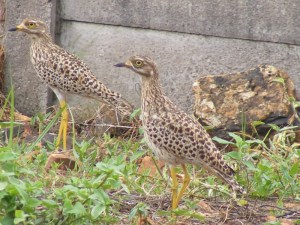>This past December I have been with some of my friends on holiday. The first part of the holiday was in Manaba beach and the second part at the Fish River Sun in Port Alfred (via Hogsback).
Manaba beach (next to Uvongo)
Each morning I got up very early to sit on the veranda or walk down to the beach. One afternoon I spotted an albatross (looked like a giant albatross, but it was to far) flying over the waves. Unfortunately I didn’t manage to take a photo because of the distance. After the sighting of the Albatross, I saw another biggish bird flying over the beach. I followed it hoping that it would be some new sea bird (my list have very limited sea birds). Going closer eventually it appeared to be a Giant Kingfisher…well he was pretty too, but already on my list:
The one thing that amazed me is how many Burchell’s Coucal I saw in the open. In the short time we were there (5 days) I took 2 nice photos:


The garden of the house we were staying is
flourished with weavers and canaries. Two of the special ones
for me were the Yellow-fronted Canary and the Yellow Weaver:



A new (probably common bird for some) bird I also saw was the Southern Grey-headed Sparrow. Then I thought…it’s so easy to just not look carefully and presume it’s probably a House Weaver…until you look closer :
:
Since it was summer, there where also plenty of Lesser
Striped Swallows in the air:

In the garden there lived a pair of Amethyst sunbirds. Here I took a quick photo of the female taking off (it was not planned…she was still when I aimed)

Like all places, the Myna’s are taking over. They did look kind of funny, is seen from this photo. Mynas photo (com’on! You don’t possess the lawn!)

One afternoon I heard a very familiar bird call and when I looks outside, I saw to my surprise a lovebird…that’s what I initially thought. But after my posting some (much more clever) guys at Birdnet corrected me. According to me and after further investigation I found that this is in fact a Cape Parrot!!! I was very delighted because how many times do you get the chance seeing this special bird? This appears to be a female and shows all the characteristics of a cape parrot. (Thank you everyone helping me out with this one)

Hogsback (in the Amatholo Mountains – Eastern Cape)
The second leg of my holiday where just magical. On our way to the Fish River Sun we stayed over one night in Hogsback. Hogsback is a small community with so many B&B’s you can think in a magical forest. Here is a photo of the view from the honeymoon suite’s balcony.
We didn’t stay there, but this is the view from the self catering cottage, The Edge, we stayed at.
Considering it was just one night, I saw to very special birds…and even took a photo of each.

Red-chrested Cuckoo (Piet-my-vrou)

Rameron pigeon
The Red-chrested cuckoo (Piet-my-vrou) I spotted on our way out the next morning when I just insisted that the driver had to stop. I was so excited…this was the first time I spotted a Red-chrested and even could take a photo!
I found the Rameron pigeon late the afternoon when I went for a walk around the place near the Honeymoon cottage.
For the short duration of our stay, I heard the Knysna Turaco the whole time…they were very active, but I couldn’t manage to spot one clearly. The only slight sighting was when we arrived the afternoon and I spotted the crimson red of the turaco quickly flying over the road.
Fish River Sun (near Port Alfred)
After the one night in Hogsback we took off to the Fish River Sun. If you aren’t a keen golfer or fisherman, swimming, hiking and bird watching is the only two other things to do. Luckily I could do some bird watching.
Almost everyday we strolled along the beach to Bats Cave. Along the way, every time I found the same pair of African Black Oystercatchers. Because it was my first sighting of them, I took some photos:



Near the cave the pied kingfishers were feeding (in the ocean of course):
Some of the other birds on the beach also where this White-fronted plover:
During the days we stayed there, the Helmeted Guineafowls were feeding at our sliding door (feeding from the bread we gave them) One morning it rained so much…but this didn’t seem to bother these birds. I must admit, I’ve never seen soaking wet guineafowl before.

In the surrounding gardens and gholf course I had 2 first sightings. The one is the Black winged Lapwing and the other the Greater double-collared sunbird. Unfortunately not one of my photos of the Black winged lapwing was good enough for the site because of the distance I photographed them.
My last sighting was so exciting; I just had to keep it to the end. As with Hogsback, the Knysna Turaco were again very load. The last evening of our stay, I heard their diagnostic sound like some kind of weird ape. I ran into the unit to get my camera and initially could only get pictures like these:

I went trigger happy with my camera hoping to get just a bit lucky with the bird coming more into the open branches…and so it did:
This was a wonderful trip for me; and did do my life list very good since I haven’t gone bird watching for quite a while before this December.
Hope you enjoyed this festive season and a very good birding year to you all!























